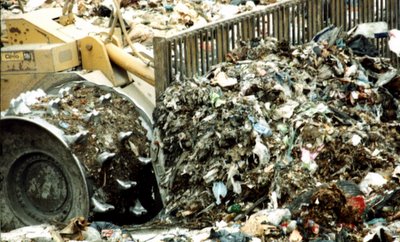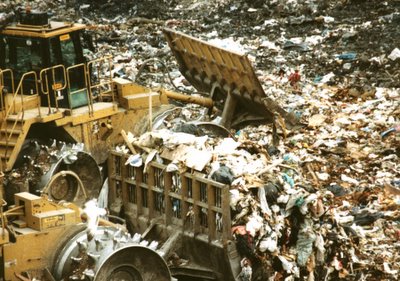Landfill faces time limit to answer OEPA concerns
 By Deanne Johnson
By Deanne JohnsonMorning Journal Staff Writer
December 9, 2005
Lisbon, Ohio
NEGLEY, Ohio - Penn-Ohio Recycling's construction demolition debris landfill above Negley may need to make some changes to stay in compliance with the Ohio Environmental Protection Agency after an inspection found seven concerns.
Following up on complaints from the Middleton Township trustees and three local residents, the OEPA inspected the site Sept. 28 and then filed the letter stating the concerns on Nov. 21 with Guy Fragle of Total Waste Logistics Inc. of Sharpsville, Pa., the company which oversees the Negley site.
The letter gives Fragle until Dec. 15 to respond to the concerns of the inspection.
The concerns include findings that the site's storm water pollution prevention plan filed in July 2000 when the landfill was applying for approval was not being followed now. There has been no updated plan available, according to the OEPA, and only one of the sediment ponds on the plan actually has been constructed.
Because of failure to comply with the plan, the OEPA letter continues, there are now seven storm water concerns.
- The road ditches along the entrance drive and haul roads are not stable and erode with each rainfall. The letter suggests several steps to correct the problems, including cleaning out sediment traps.
- The leachate collection system implemented to control storm water coming into contact with waste at the rail car unloading area does not appear to capture all such storm water. While there is a system in place, the letter continues that it is caked with mud from truck tires. There is also a problem, according to the letter, catching waste dropped from railroad cars on the south side of the tracks - which is toward Negley.
- Another concern was with runoff flowing east onto a wetland-like area and into the yard of a neighbor.
- The letter further questions the lack of sediment or erosion controls in place from the soil in the "dump area." Soil, which was moved to be used later as cap material, reportedly has been placed on and over a hillside, creating a steep, bare slope.
- Another concern was with the face of waste cell No. 1, which reportedly has been bare and idle for about one year. According to requirements, it should have been stabilized within seven days of the last disturbance if it was to remain idle for 45 days or more.
- The letter states that there is exposed waste on areas that have been capped. Such exposed waste can cause storm water running off the area to become wastewater.
- Finally, the letter states that on Oct. 26, the engineer saw from another property that it appears fill material has been placed in an unnamed tributary to Leslie Run and that material has been washing down into Leslie Run.
The letter concludes that while it may be difficult to address some of the issues during the winter, it is necessary to complete stabilization in the spring of 2006.
Middleton Township trustees discussed the letter Monday and also talked about ways to make sure they are receiving the full amount of tipping money that they are due.
Judging by the amount the township recently received, Trustee Brad Bosley said he estimates about 12 railroad cars of demolition debris per day are being brought to the site, which would total 1,500 cars per year.


 But in the settlement,
But in the settlement, 












